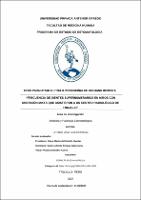Frecuencia de dientes supernumerarios en niños con dentición mixta que asistieron a un centro radiológico de Trujillo
Resumen
Determinar la frecuencia de dientes supernumerarios en niños con dentición mixta que asistieron a un centro radiológico de Trujillo.
Materiales y métodos: El estudio fue transversal y observacional, se evaluó un total de 500 radiografías panorámicas de niños y niñas con dentición mixta que asistieron a un centro radiológico de Trujillo. Para este estudio observacional se hizo uso de una ficha de recolección de datos que para determinar la confiabilidad se usó el índice de Kappa, obteniendo como resultado 1(casi perfecto) entre el investigador y la experta en radiología. Los datos recolectados se analizaron aplicando el programa Excel 2021 y el paquete estadístico SPSS versión 20. Los datos recogidos fueron procesados usando estadística descriptiva a través de tablas de frecuencia correspondientes a los objetivos propuestos; además de estadística inferencial mediante la prueba de chi-cuadrado.
Resultados: La frecuencia de dientes supernumerarios en niños con dentición mixta que asistieron a un centro radiológico de Trujillo es 5%. De los 25 niños que presentaron dientes supernumerarios según la ubicación, el 76% fueron mesiodens, 24% parapremolares, y no se encontraron dientes supernumerarios paramolares ni distomolares. Según la edad, entre el rango de 6 a 8 años, sólo el 4%; entre 9 y 10 años, el 3% y finalmente, entre 11 y 12 años, el 9% de ellos presentaron dientes supernumerarios. Según el sexo, de los 243 niños sólo el 5% presentó dientes supernumerarios. En cuanto a las niñas, de las 257 evaluadas, sólo el 5% presentaron dientes supernumerarios.
Conclusiones: La frecuencia de dientes supernumerarios en niños con dentición mixta que asistieron a un centro radiológico de Trujillo es 5%. Donde los más frecuentes fueron los mesiodens. El rango de edad más frecuente fue entre 11 y 12 años y según su género se obtuvo porcentajes iguales, sin ninguna significancia entre la variable y las covariables edad y género. To determine the frequency of supernumerary teeth in children with mixed dentition who attended a radiological center in Trujillo.
Materials and methods: The study was cross-sectional and observational, a total of 500 panoramic radiographs of boys and girls with mixed dentition who attended a radiological center in Trujillo were evaluated. For this observational study, a data collection sheet was used, which used the Kappa index to determine reliability, obtaining a result of 1 (almost perfect) between the researcher and the radiology expert. The collected data was analyzed using the Excel 2021 program and the statistical package SPSS version 20. The collected data was processed using descriptive statistics through frequency tables corresponding to the proposed objectives; in addition to inferential statistics using the chi-square test.
Results: The frequency of supernumerary teeth in children with mixed dentition who attended a radiological center in Trujillo is 5%. Of the 25 children who presented supernumerary teeth according to location, 76% were mesiodens, 24% parapremolar, and no paramolar or distomolar supernumerary teeth were found. According to age, between the range of 6 to 8 years, only 4%; between 9 and 10 years, 3% and finally, between 11 and 12 years, 9% of them presented supernumerary teeth. According to sex, of the 243 children, only 5% had supernumerary teeth. Regarding the girls, of the 257 evaluated, only 5% presented supernumerary teeth.
Conclusions: The frequency of supernumerary teeth in children with mixed dentition who attended a radiological center in Trujillo is 5%. Where the most frequent were the mesiodens. The most frequent age range was between 11 and 12 years and according to their gender, equal percentages were obtained, without any significance between the variable and the covariates of age and gender
Palabras clave
Colecciones
- Estomatología [653]


